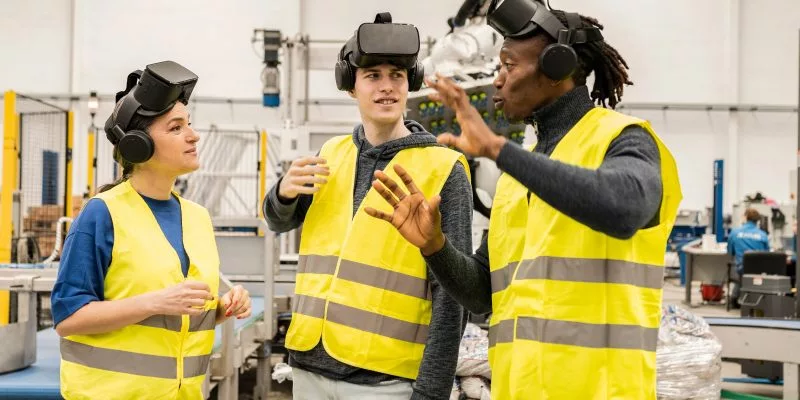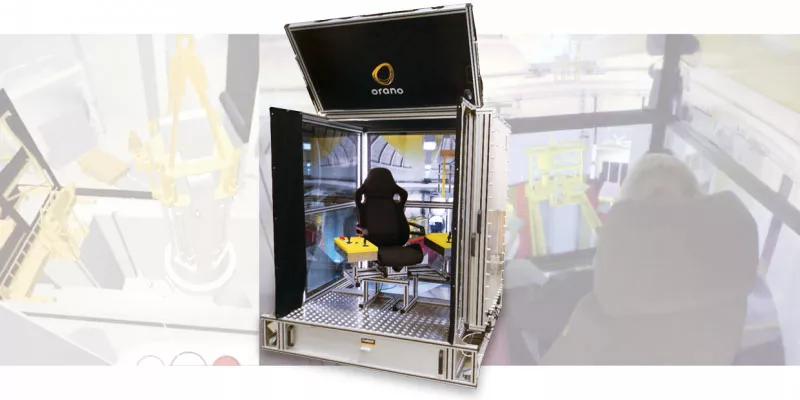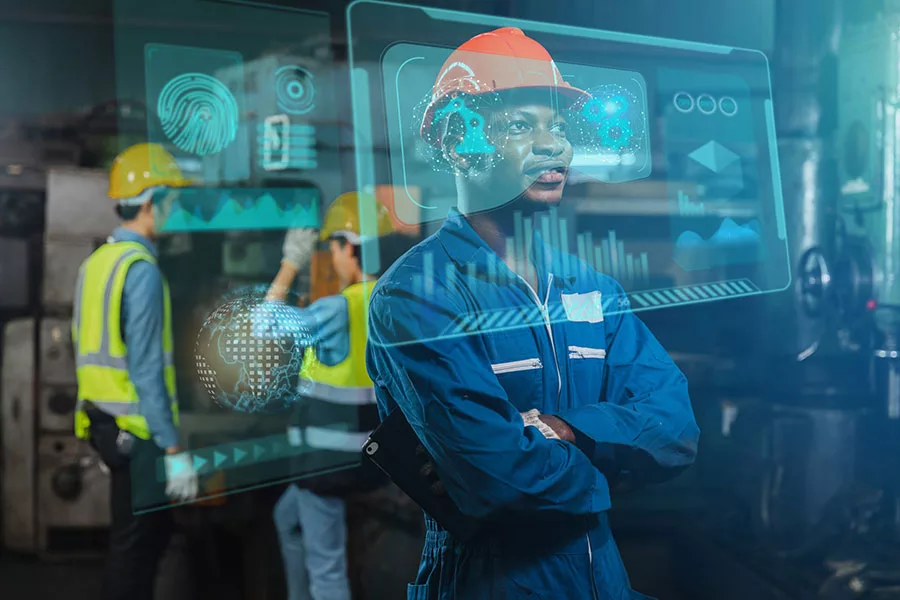Between fantasy and reality, the Metaverse has been generating increasing interest for several months and is opening up new possibilities, particularly in the field of professional training.
Some companies do not hesitate to rely on immersion in multi-player virtual environments to train future employees for working conditions, develop their skills, and improve their operational performance.
In his “Live Session” on February 1, 2023, during the Learning Technologies exhibition, Jérôme Poulain demonstrated the potential and power of multi-player simulation in a virtual universe for training purposes. His remarks are illustrated with concrete cases in the fields of industry and logistics.
To begin with, what is the Metaverse?
« Contrary to what one might imagine, the Metaverses are not entirely new. They have actually existed for quite some time. The first Metaverse I personally played was HABBO. And that’s not very recent! You may have participated in a major virtual game that became widely popular worldwide in 2003: Second Life. Second Life was already a large Metaverse, marketed with customizable characters, shops, and more… You could have any appearance you wanted there.
Today, many people dream of Metaverses like those depicted in movies such as READY PLAYER ONE, for example: a unified global game where everyone plays in the same world. But in video games, there are already many Metaverses!
Most of the time, they are more like games with a persistent universe. I can connect from anywhere, at any time: the game is open and continues to live even if I’m not connected to it. For example, if I built something in the game, when I return, it might have disappeared because others who continue to play may have destroyed it. This type of immersive game, therefore, creates a strong dependency.
Immersive learning: for a borderless learning experience
“So today, indeed, we can offer learners the opportunity to immerse themselves in the same environment with a virtual reality headset. And ensure that everyone works in a collaborative mode rather than necessarily in a competitive one.”
To do this, it is necessary to create a virtual environment. This is a 3D environment where, for example, we can recreate all the machines in a workshop and their operating processes. If needed, it is even possible to create a dynamic environment controlled by artificial intelligence.
The advantage of this type of virtual learning is that learners do not have to be in the same location to benefit from the same training.
We can invite someone in Paris and another in New York. Both participants will collaborate simply by wearing a VR headset. They will be in the same environment and can, of course, communicate. For more realism, we can also inject inputs managed by the application. For example, creating more natural scenarios and complexity in mission execution. »
When pedagogy meets digital technology
« Initial pedagogy is transmissive from the adult to the child. Then, we shifted this with the concept of andragogy. It was recognized that you cannot work with an adult the same way you would with a child. Indeed, with an adult, training cannot be solely vertical. It is necessary to obtain feedback, trigger richer and more interactive activities, and thus adopt “inductive” pedagogies (which proceed by induction). We will therefore introduce diversity into the approaches.
Today, we are more likely to talk about “heutagogy.” Heutagogy is about placing the learner at the center of a training system where they are “taught to learn.” They are taught how to use an environment, and then they are free to seek out all the knowledge components they need to progress.
This new type of pedagogy is made possible by the development of platforms and environments such as professional Metaverses. »
The professional Metaverse: a digital training that is supported and personalized
“In these professional Metaverses, there is learning and direction, thus a mission. Naturally, there still is” trainers alongside the learners. They also act as moderators . These environments will be called “virtual campuses.“
It is entirely possible to create a Metaverse-type virtual campus for a company, while still limiting it. It will not be universal but specific to the company. It will recreate the entire internal process: from production units to sales, including commercial administration, customer service, and more.
From then on, it can be envisioned in multi-player mode. We should no longer think of an immersive experience as just a single learner reacting to an avatar that provides information or small inputs. It is now possible to have many participants.
The trainer can also be present. They can wear a headset and immerse themselves in virtual reality to support their learners. This makes it possible to consider a mentoring approach.

“The major advantage of this type of virtual training is that it allows you to engage your motor functions, such as your body and strength (for example: through haptic gloves, walking mats, etc.).”
The same can be done with emotional functions: virtual reality generates a range of emotions that are the natural emotions of everyday work. For example, if you are afraid of heights in real life, you will also experience that fear in virtual reality!
There are other sensory functions, such as smell. Today, there are interfaces that allow for the coupling of computer-controlled scent diffusers… The immersion becomes even more intense. For example, a learner can be confronted with a virtual fire in a warehouse, like a burning jerrycan. The learner could smell the oil and even experience a rise in temperature. It is indeed possible to control radiants that will turn on and increase in intensity as the person approaches the fire. Since the person is wearing a VR headset, they experience things much more intensely.
The benefit of these experiences is also to collect data from the learner, such as physiological data.
This is how Audace designed a crane simulator where the crane operator is equipped with a bracelet that collects three types of data: heart rate, sweating, and body temperature. These data, interpreted by AI, allow for the measurement of the operator’s stress and the tipping point between positive stress (maximum attention) and negative stress (loss of control).

When to use the Metaverse in a professional environment?
“We prioritize virtual reality and this type of ‘Metaverse’ environment in situations that meet one of the 4Rs:
- Rare situations: For example, I need to perform maintenance in a highly radioactive environment. I have 30 seconds to do it because I will receive a month’s worth of radiation exposure. I will train using virtual reality to do it in an environment as close to reality as possible.
- Risk situations: I want to train someone for working at heights. I will have them try a boom lift simulator and virtually take them to 100 meters high to see if they can indeed handle working in the lift without it becoming a professional hazard.
- Repetitive situations: In the sense of practicing before a sensitive operation. If I need to perform a lifting operation that could cause damage if the object being lifted detaches or follows an incorrect trajectory, I practice the maneuvers virtually before facing the real task.
- Repetitive situations: On a machine integrated into a production line, I need to reach a certain level and pace. It’s not just about knowing how to perform a task; it’s about doing it within the allotted time. To achieve the required productivity level, it is very effective to train, stress-free, in virtual reality. The tool will help detect where I gain or lose time. The computer records everything and can provide metrics on what was done well or poorly. Thus, both the trainer and I will have extremely precise feedback on my ability to complete a task.
Listen to the replay
Audace supports you
“Audace is currently designing a Metaverse-type simulator. It will operate in the world of logistics. In this virtual environment, several learners will train for their future roles (pickers, co-packers, forklift operators). They will need to collaborate to complete a task: send a pallet within a given time. The trainer will be able to either observe what the learners are doing from their computer screen or put on a virtual reality headset and guide them.
In conclusion, we already know how to create professional Metaverses for virtual campuses. They are already being used! So, why not you?

